Health Variations 2 Assessment 2: Case Study
VerifiedAdded on 2023/06/08
|10
|2277
|416
AI Summary
This case study discusses the medication routine for subcutaneous insulin, the use of NovoRapid insulin for type 1 diabetes, potential adverse effects, and nursing assessments. It also covers the daily physical and emotional challenges of living with type 1 diabetes.
Contribute Materials
Your contribution can guide someone’s learning journey. Share your
documents today.
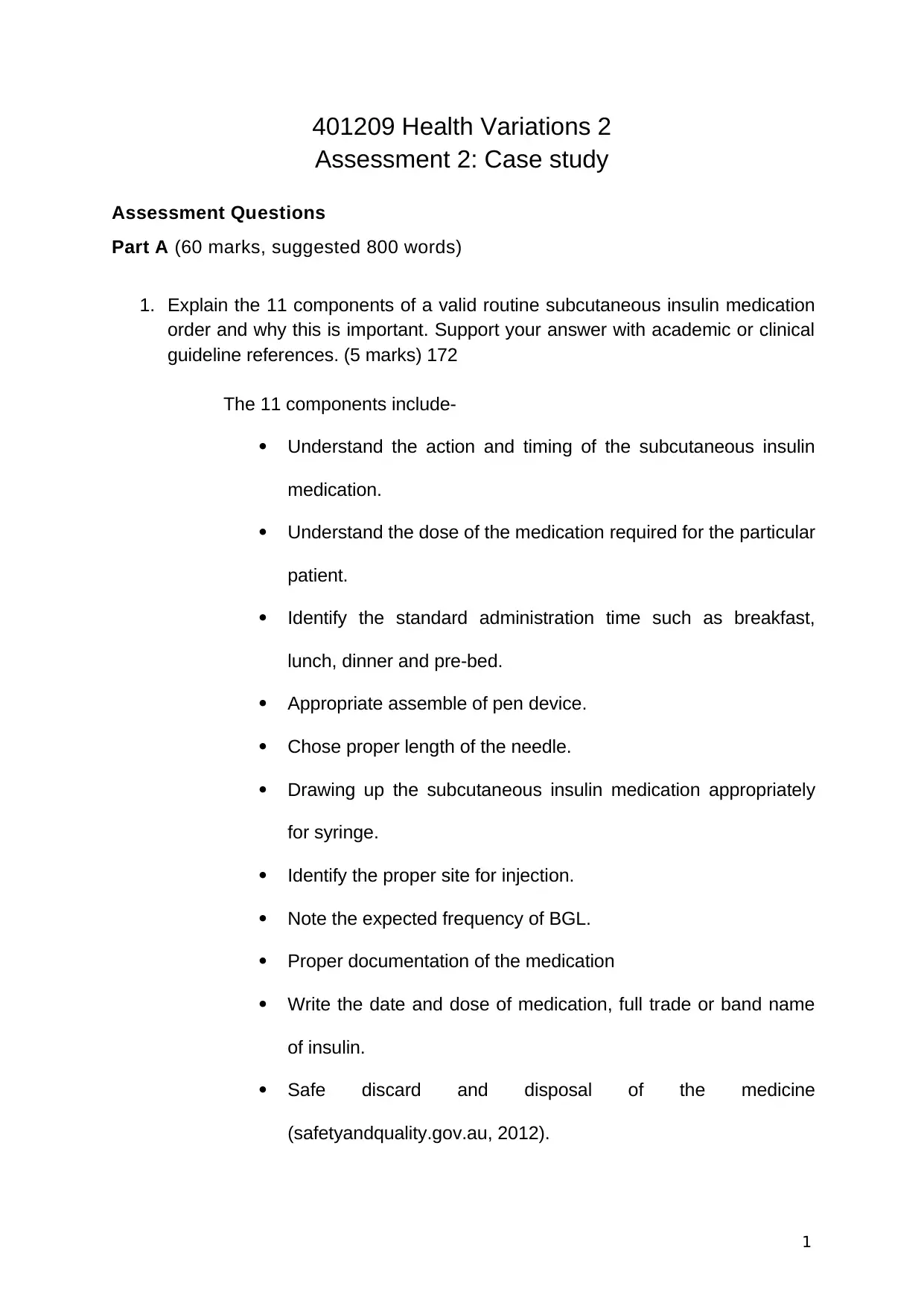
401209 Health Variations 2
Assessment 2: Case study
Assessment Questions
Part A (60 marks, suggested 800 words)
1. Explain the 11 components of a valid routine subcutaneous insulin medication
order and why this is important. Support your answer with academic or clinical
guideline references. (5 marks) 172
The 11 components include-
Understand the action and timing of the subcutaneous insulin
medication.
Understand the dose of the medication required for the particular
patient.
Identify the standard administration time such as breakfast,
lunch, dinner and pre-bed.
Appropriate assemble of pen device.
Chose proper length of the needle.
Drawing up the subcutaneous insulin medication appropriately
for syringe.
Identify the proper site for injection.
Note the expected frequency of BGL.
Proper documentation of the medication
Write the date and dose of medication, full trade or band name
of insulin.
Safe discard and disposal of the medicine
(safetyandquality.gov.au, 2012).
1
Assessment 2: Case study
Assessment Questions
Part A (60 marks, suggested 800 words)
1. Explain the 11 components of a valid routine subcutaneous insulin medication
order and why this is important. Support your answer with academic or clinical
guideline references. (5 marks) 172
The 11 components include-
Understand the action and timing of the subcutaneous insulin
medication.
Understand the dose of the medication required for the particular
patient.
Identify the standard administration time such as breakfast,
lunch, dinner and pre-bed.
Appropriate assemble of pen device.
Chose proper length of the needle.
Drawing up the subcutaneous insulin medication appropriately
for syringe.
Identify the proper site for injection.
Note the expected frequency of BGL.
Proper documentation of the medication
Write the date and dose of medication, full trade or band name
of insulin.
Safe discard and disposal of the medicine
(safetyandquality.gov.au, 2012).
1
Secure Best Marks with AI Grader
Need help grading? Try our AI Grader for instant feedback on your assignments.
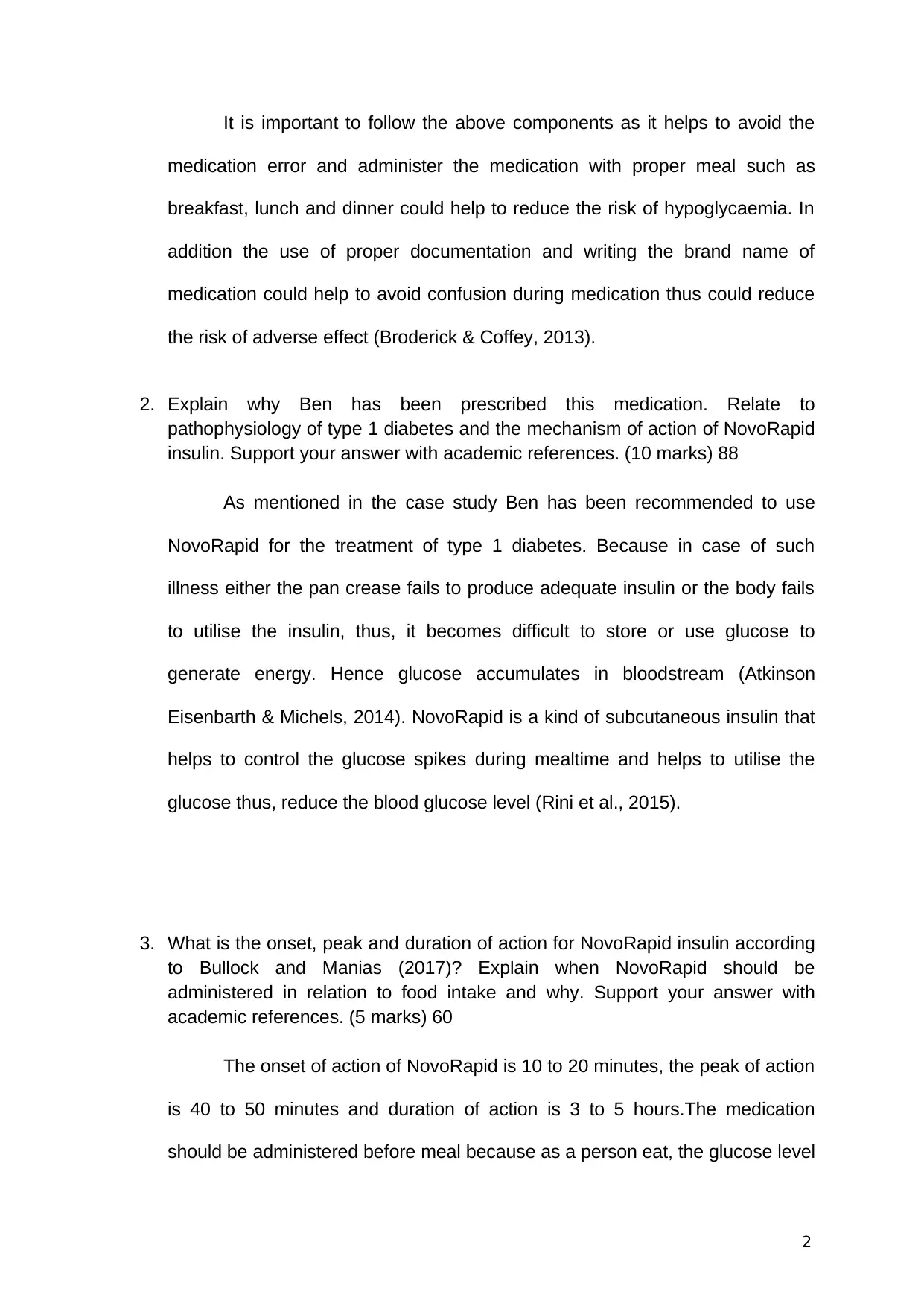
It is important to follow the above components as it helps to avoid the
medication error and administer the medication with proper meal such as
breakfast, lunch and dinner could help to reduce the risk of hypoglycaemia. In
addition the use of proper documentation and writing the brand name of
medication could help to avoid confusion during medication thus could reduce
the risk of adverse effect (Broderick & Coffey, 2013).
2. Explain why Ben has been prescribed this medication. Relate to
pathophysiology of type 1 diabetes and the mechanism of action of NovoRapid
insulin. Support your answer with academic references. (10 marks) 88
As mentioned in the case study Ben has been recommended to use
NovoRapid for the treatment of type 1 diabetes. Because in case of such
illness either the pan crease fails to produce adequate insulin or the body fails
to utilise the insulin, thus, it becomes difficult to store or use glucose to
generate energy. Hence glucose accumulates in bloodstream (Atkinson
Eisenbarth & Michels, 2014). NovoRapid is a kind of subcutaneous insulin that
helps to control the glucose spikes during mealtime and helps to utilise the
glucose thus, reduce the blood glucose level (Rini et al., 2015).
3. What is the onset, peak and duration of action for NovoRapid insulin according
to Bullock and Manias (2017)? Explain when NovoRapid should be
administered in relation to food intake and why. Support your answer with
academic references. (5 marks) 60
The onset of action of NovoRapid is 10 to 20 minutes, the peak of action
is 40 to 50 minutes and duration of action is 3 to 5 hours.The medication
should be administered before meal because as a person eat, the glucose level
2
medication error and administer the medication with proper meal such as
breakfast, lunch and dinner could help to reduce the risk of hypoglycaemia. In
addition the use of proper documentation and writing the brand name of
medication could help to avoid confusion during medication thus could reduce
the risk of adverse effect (Broderick & Coffey, 2013).
2. Explain why Ben has been prescribed this medication. Relate to
pathophysiology of type 1 diabetes and the mechanism of action of NovoRapid
insulin. Support your answer with academic references. (10 marks) 88
As mentioned in the case study Ben has been recommended to use
NovoRapid for the treatment of type 1 diabetes. Because in case of such
illness either the pan crease fails to produce adequate insulin or the body fails
to utilise the insulin, thus, it becomes difficult to store or use glucose to
generate energy. Hence glucose accumulates in bloodstream (Atkinson
Eisenbarth & Michels, 2014). NovoRapid is a kind of subcutaneous insulin that
helps to control the glucose spikes during mealtime and helps to utilise the
glucose thus, reduce the blood glucose level (Rini et al., 2015).
3. What is the onset, peak and duration of action for NovoRapid insulin according
to Bullock and Manias (2017)? Explain when NovoRapid should be
administered in relation to food intake and why. Support your answer with
academic references. (5 marks) 60
The onset of action of NovoRapid is 10 to 20 minutes, the peak of action
is 40 to 50 minutes and duration of action is 3 to 5 hours.The medication
should be administered before meal because as a person eat, the glucose level
2
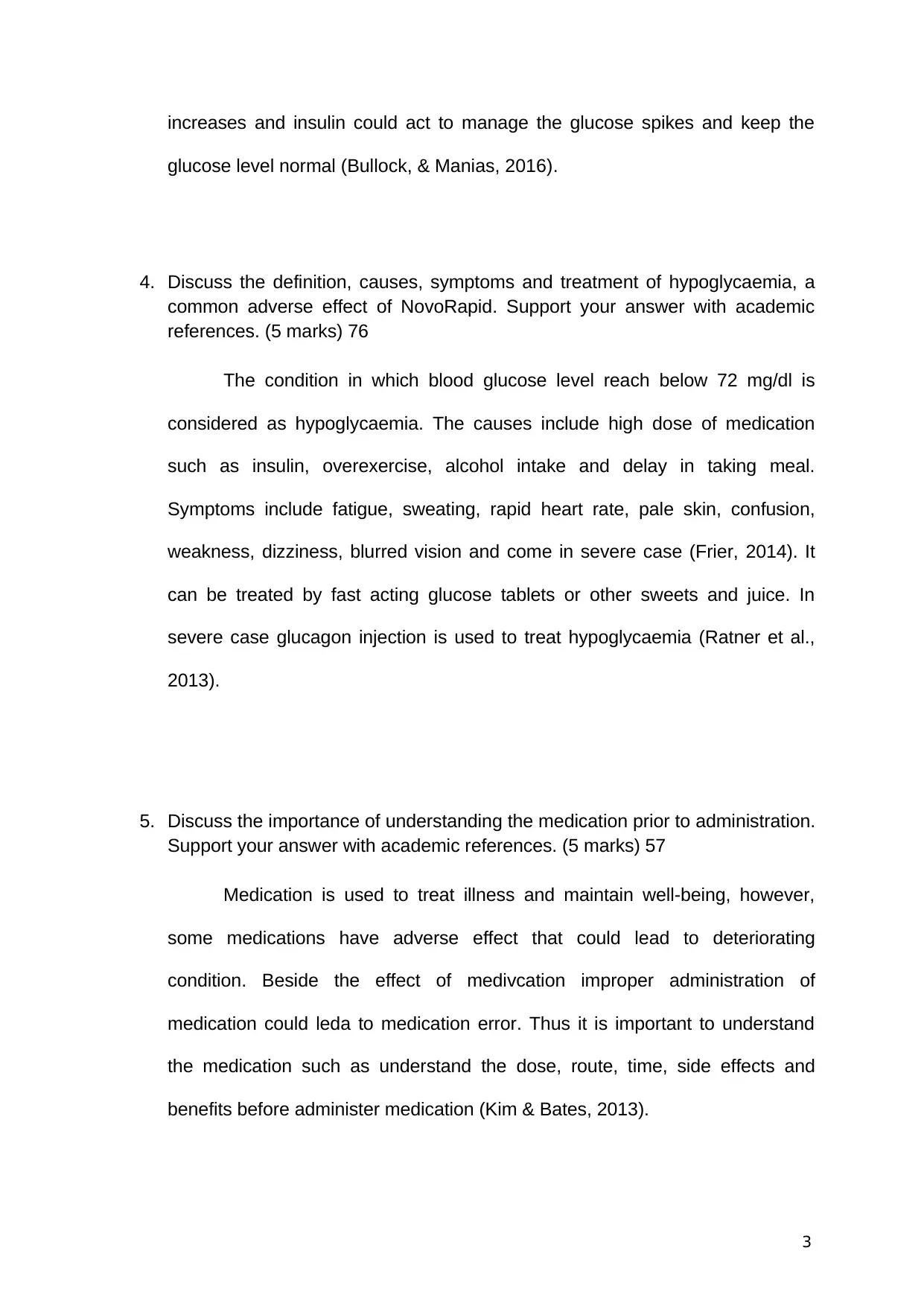
increases and insulin could act to manage the glucose spikes and keep the
glucose level normal (Bullock, & Manias, 2016).
4. Discuss the definition, causes, symptoms and treatment of hypoglycaemia, a
common adverse effect of NovoRapid. Support your answer with academic
references. (5 marks) 76
The condition in which blood glucose level reach below 72 mg/dl is
considered as hypoglycaemia. The causes include high dose of medication
such as insulin, overexercise, alcohol intake and delay in taking meal.
Symptoms include fatigue, sweating, rapid heart rate, pale skin, confusion,
weakness, dizziness, blurred vision and come in severe case (Frier, 2014). It
can be treated by fast acting glucose tablets or other sweets and juice. In
severe case glucagon injection is used to treat hypoglycaemia (Ratner et al.,
2013).
5. Discuss the importance of understanding the medication prior to administration.
Support your answer with academic references. (5 marks) 57
Medication is used to treat illness and maintain well-being, however,
some medications have adverse effect that could lead to deteriorating
condition. Beside the effect of medivcation improper administration of
medication could leda to medication error. Thus it is important to understand
the medication such as understand the dose, route, time, side effects and
benefits before administer medication (Kim & Bates, 2013).
3
glucose level normal (Bullock, & Manias, 2016).
4. Discuss the definition, causes, symptoms and treatment of hypoglycaemia, a
common adverse effect of NovoRapid. Support your answer with academic
references. (5 marks) 76
The condition in which blood glucose level reach below 72 mg/dl is
considered as hypoglycaemia. The causes include high dose of medication
such as insulin, overexercise, alcohol intake and delay in taking meal.
Symptoms include fatigue, sweating, rapid heart rate, pale skin, confusion,
weakness, dizziness, blurred vision and come in severe case (Frier, 2014). It
can be treated by fast acting glucose tablets or other sweets and juice. In
severe case glucagon injection is used to treat hypoglycaemia (Ratner et al.,
2013).
5. Discuss the importance of understanding the medication prior to administration.
Support your answer with academic references. (5 marks) 57
Medication is used to treat illness and maintain well-being, however,
some medications have adverse effect that could lead to deteriorating
condition. Beside the effect of medivcation improper administration of
medication could leda to medication error. Thus it is important to understand
the medication such as understand the dose, route, time, side effects and
benefits before administer medication (Kim & Bates, 2013).
3
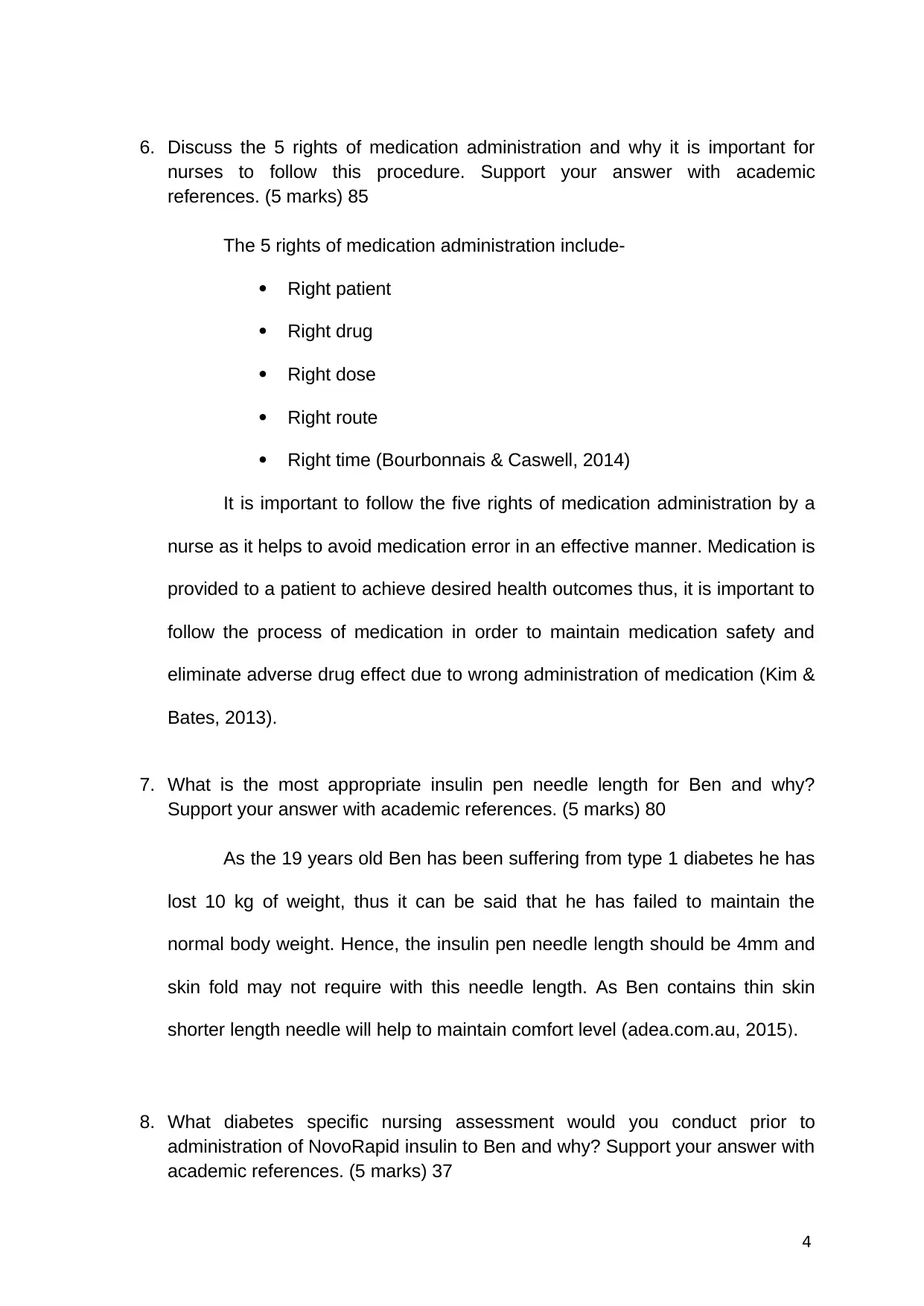
6. Discuss the 5 rights of medication administration and why it is important for
nurses to follow this procedure. Support your answer with academic
references. (5 marks) 85
The 5 rights of medication administration include-
Right patient
Right drug
Right dose
Right route
Right time (Bourbonnais & Caswell, 2014)
It is important to follow the five rights of medication administration by a
nurse as it helps to avoid medication error in an effective manner. Medication is
provided to a patient to achieve desired health outcomes thus, it is important to
follow the process of medication in order to maintain medication safety and
eliminate adverse drug effect due to wrong administration of medication (Kim &
Bates, 2013).
7. What is the most appropriate insulin pen needle length for Ben and why?
Support your answer with academic references. (5 marks) 80
As the 19 years old Ben has been suffering from type 1 diabetes he has
lost 10 kg of weight, thus it can be said that he has failed to maintain the
normal body weight. Hence, the insulin pen needle length should be 4mm and
skin fold may not require with this needle length. As Ben contains thin skin
shorter length needle will help to maintain comfort level (adea.com.au, 2015).
8. What diabetes specific nursing assessment would you conduct prior to
administration of NovoRapid insulin to Ben and why? Support your answer with
academic references. (5 marks) 37
4
nurses to follow this procedure. Support your answer with academic
references. (5 marks) 85
The 5 rights of medication administration include-
Right patient
Right drug
Right dose
Right route
Right time (Bourbonnais & Caswell, 2014)
It is important to follow the five rights of medication administration by a
nurse as it helps to avoid medication error in an effective manner. Medication is
provided to a patient to achieve desired health outcomes thus, it is important to
follow the process of medication in order to maintain medication safety and
eliminate adverse drug effect due to wrong administration of medication (Kim &
Bates, 2013).
7. What is the most appropriate insulin pen needle length for Ben and why?
Support your answer with academic references. (5 marks) 80
As the 19 years old Ben has been suffering from type 1 diabetes he has
lost 10 kg of weight, thus it can be said that he has failed to maintain the
normal body weight. Hence, the insulin pen needle length should be 4mm and
skin fold may not require with this needle length. As Ben contains thin skin
shorter length needle will help to maintain comfort level (adea.com.au, 2015).
8. What diabetes specific nursing assessment would you conduct prior to
administration of NovoRapid insulin to Ben and why? Support your answer with
academic references. (5 marks) 37
4
Secure Best Marks with AI Grader
Need help grading? Try our AI Grader for instant feedback on your assignments.
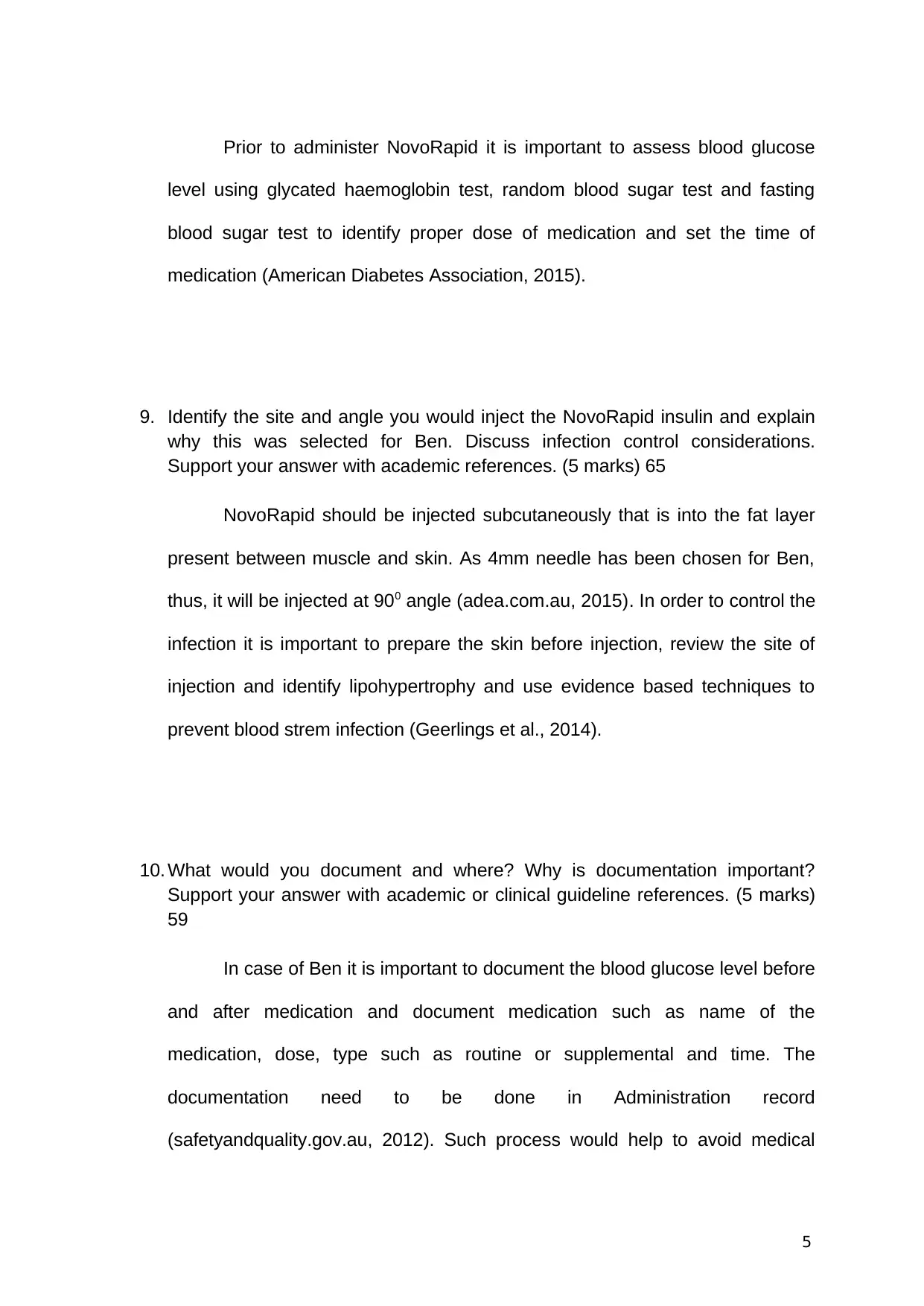
Prior to administer NovoRapid it is important to assess blood glucose
level using glycated haemoglobin test, random blood sugar test and fasting
blood sugar test to identify proper dose of medication and set the time of
medication (American Diabetes Association, 2015).
9. Identify the site and angle you would inject the NovoRapid insulin and explain
why this was selected for Ben. Discuss infection control considerations.
Support your answer with academic references. (5 marks) 65
NovoRapid should be injected subcutaneously that is into the fat layer
present between muscle and skin. As 4mm needle has been chosen for Ben,
thus, it will be injected at 900 angle (adea.com.au, 2015). In order to control the
infection it is important to prepare the skin before injection, review the site of
injection and identify lipohypertrophy and use evidence based techniques to
prevent blood strem infection (Geerlings et al., 2014).
10. What would you document and where? Why is documentation important?
Support your answer with academic or clinical guideline references. (5 marks)
59
In case of Ben it is important to document the blood glucose level before
and after medication and document medication such as name of the
medication, dose, type such as routine or supplemental and time. The
documentation need to be done in Administration record
(safetyandquality.gov.au, 2012). Such process would help to avoid medical
5
level using glycated haemoglobin test, random blood sugar test and fasting
blood sugar test to identify proper dose of medication and set the time of
medication (American Diabetes Association, 2015).
9. Identify the site and angle you would inject the NovoRapid insulin and explain
why this was selected for Ben. Discuss infection control considerations.
Support your answer with academic references. (5 marks) 65
NovoRapid should be injected subcutaneously that is into the fat layer
present between muscle and skin. As 4mm needle has been chosen for Ben,
thus, it will be injected at 900 angle (adea.com.au, 2015). In order to control the
infection it is important to prepare the skin before injection, review the site of
injection and identify lipohypertrophy and use evidence based techniques to
prevent blood strem infection (Geerlings et al., 2014).
10. What would you document and where? Why is documentation important?
Support your answer with academic or clinical guideline references. (5 marks)
59
In case of Ben it is important to document the blood glucose level before
and after medication and document medication such as name of the
medication, dose, type such as routine or supplemental and time. The
documentation need to be done in Administration record
(safetyandquality.gov.au, 2012). Such process would help to avoid medical
5
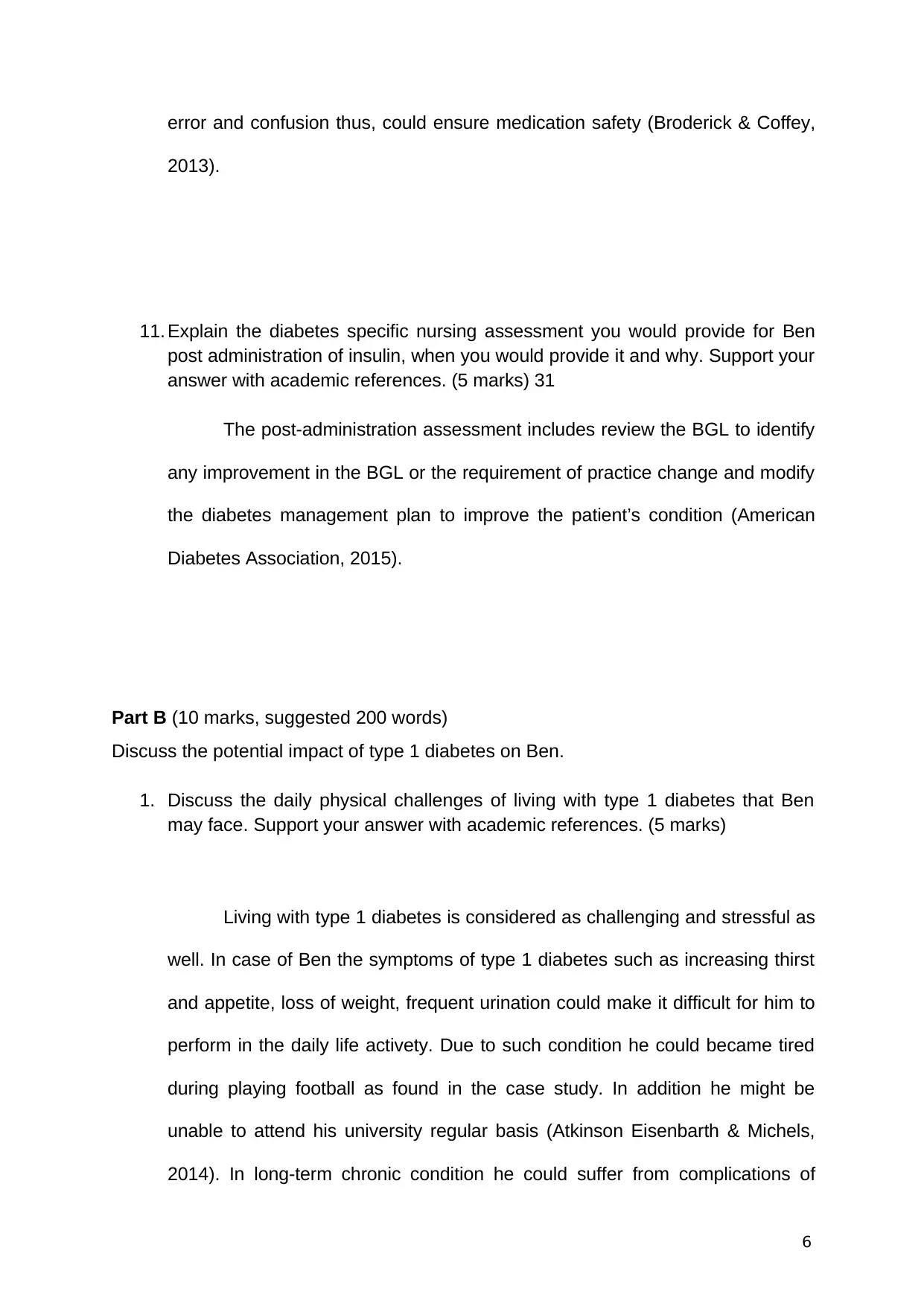
error and confusion thus, could ensure medication safety (Broderick & Coffey,
2013).
11. Explain the diabetes specific nursing assessment you would provide for Ben
post administration of insulin, when you would provide it and why. Support your
answer with academic references. (5 marks) 31
The post-administration assessment includes review the BGL to identify
any improvement in the BGL or the requirement of practice change and modify
the diabetes management plan to improve the patient’s condition (American
Diabetes Association, 2015).
Part B (10 marks, suggested 200 words)
Discuss the potential impact of type 1 diabetes on Ben.
1. Discuss the daily physical challenges of living with type 1 diabetes that Ben
may face. Support your answer with academic references. (5 marks)
Living with type 1 diabetes is considered as challenging and stressful as
well. In case of Ben the symptoms of type 1 diabetes such as increasing thirst
and appetite, loss of weight, frequent urination could make it difficult for him to
perform in the daily life activety. Due to such condition he could became tired
during playing football as found in the case study. In addition he might be
unable to attend his university regular basis (Atkinson Eisenbarth & Michels,
2014). In long-term chronic condition he could suffer from complications of
6
2013).
11. Explain the diabetes specific nursing assessment you would provide for Ben
post administration of insulin, when you would provide it and why. Support your
answer with academic references. (5 marks) 31
The post-administration assessment includes review the BGL to identify
any improvement in the BGL or the requirement of practice change and modify
the diabetes management plan to improve the patient’s condition (American
Diabetes Association, 2015).
Part B (10 marks, suggested 200 words)
Discuss the potential impact of type 1 diabetes on Ben.
1. Discuss the daily physical challenges of living with type 1 diabetes that Ben
may face. Support your answer with academic references. (5 marks)
Living with type 1 diabetes is considered as challenging and stressful as
well. In case of Ben the symptoms of type 1 diabetes such as increasing thirst
and appetite, loss of weight, frequent urination could make it difficult for him to
perform in the daily life activety. Due to such condition he could became tired
during playing football as found in the case study. In addition he might be
unable to attend his university regular basis (Atkinson Eisenbarth & Michels,
2014). In long-term chronic condition he could suffer from complications of
6
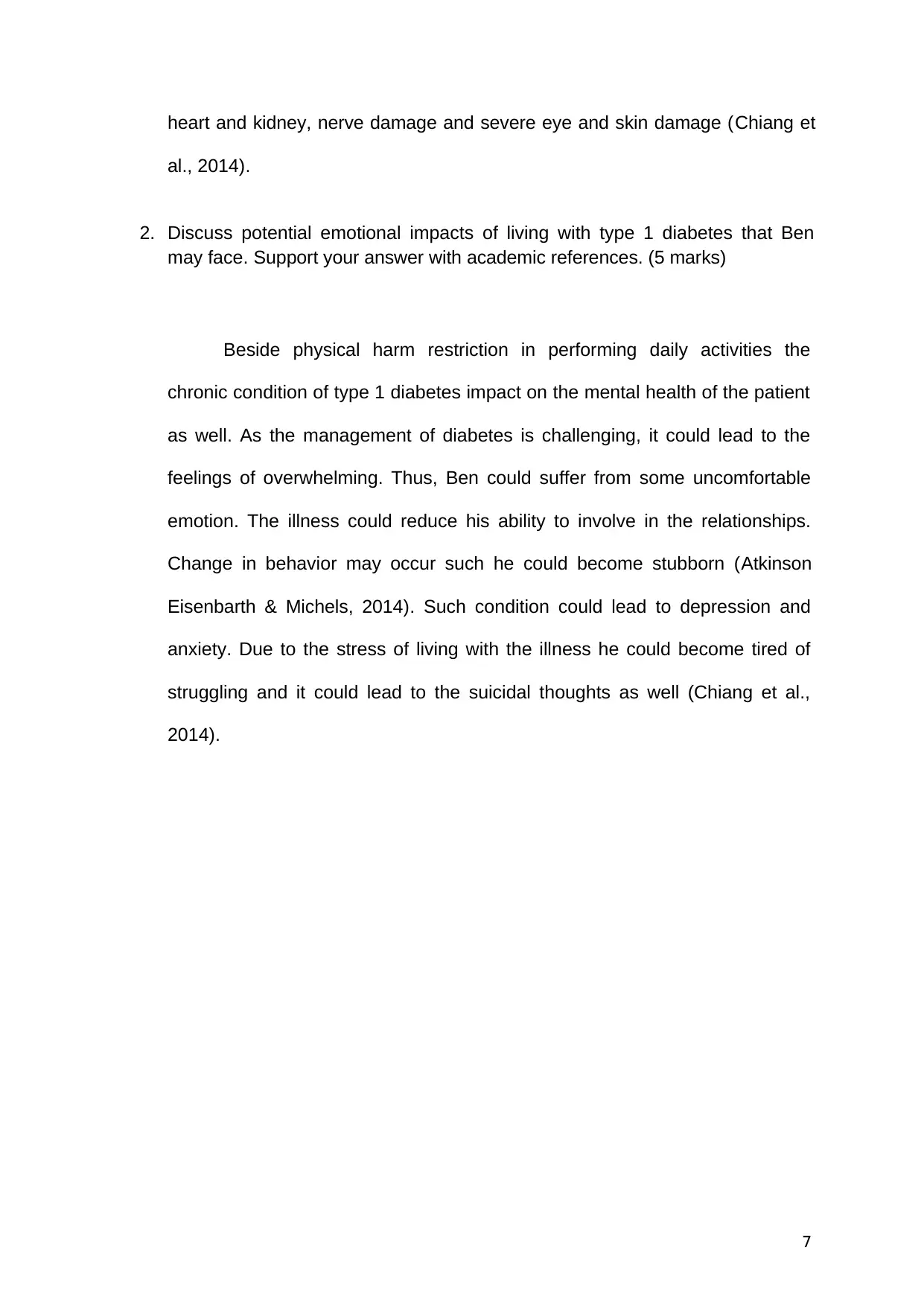
heart and kidney, nerve damage and severe eye and skin damage (Chiang et
al., 2014).
2. Discuss potential emotional impacts of living with type 1 diabetes that Ben
may face. Support your answer with academic references. (5 marks)
Beside physical harm restriction in performing daily activities the
chronic condition of type 1 diabetes impact on the mental health of the patient
as well. As the management of diabetes is challenging, it could lead to the
feelings of overwhelming. Thus, Ben could suffer from some uncomfortable
emotion. The illness could reduce his ability to involve in the relationships.
Change in behavior may occur such he could become stubborn (Atkinson
Eisenbarth & Michels, 2014). Such condition could lead to depression and
anxiety. Due to the stress of living with the illness he could become tired of
struggling and it could lead to the suicidal thoughts as well (Chiang et al.,
2014).
7
al., 2014).
2. Discuss potential emotional impacts of living with type 1 diabetes that Ben
may face. Support your answer with academic references. (5 marks)
Beside physical harm restriction in performing daily activities the
chronic condition of type 1 diabetes impact on the mental health of the patient
as well. As the management of diabetes is challenging, it could lead to the
feelings of overwhelming. Thus, Ben could suffer from some uncomfortable
emotion. The illness could reduce his ability to involve in the relationships.
Change in behavior may occur such he could become stubborn (Atkinson
Eisenbarth & Michels, 2014). Such condition could lead to depression and
anxiety. Due to the stress of living with the illness he could become tired of
struggling and it could lead to the suicidal thoughts as well (Chiang et al.,
2014).
7
Paraphrase This Document
Need a fresh take? Get an instant paraphrase of this document with our AI Paraphraser
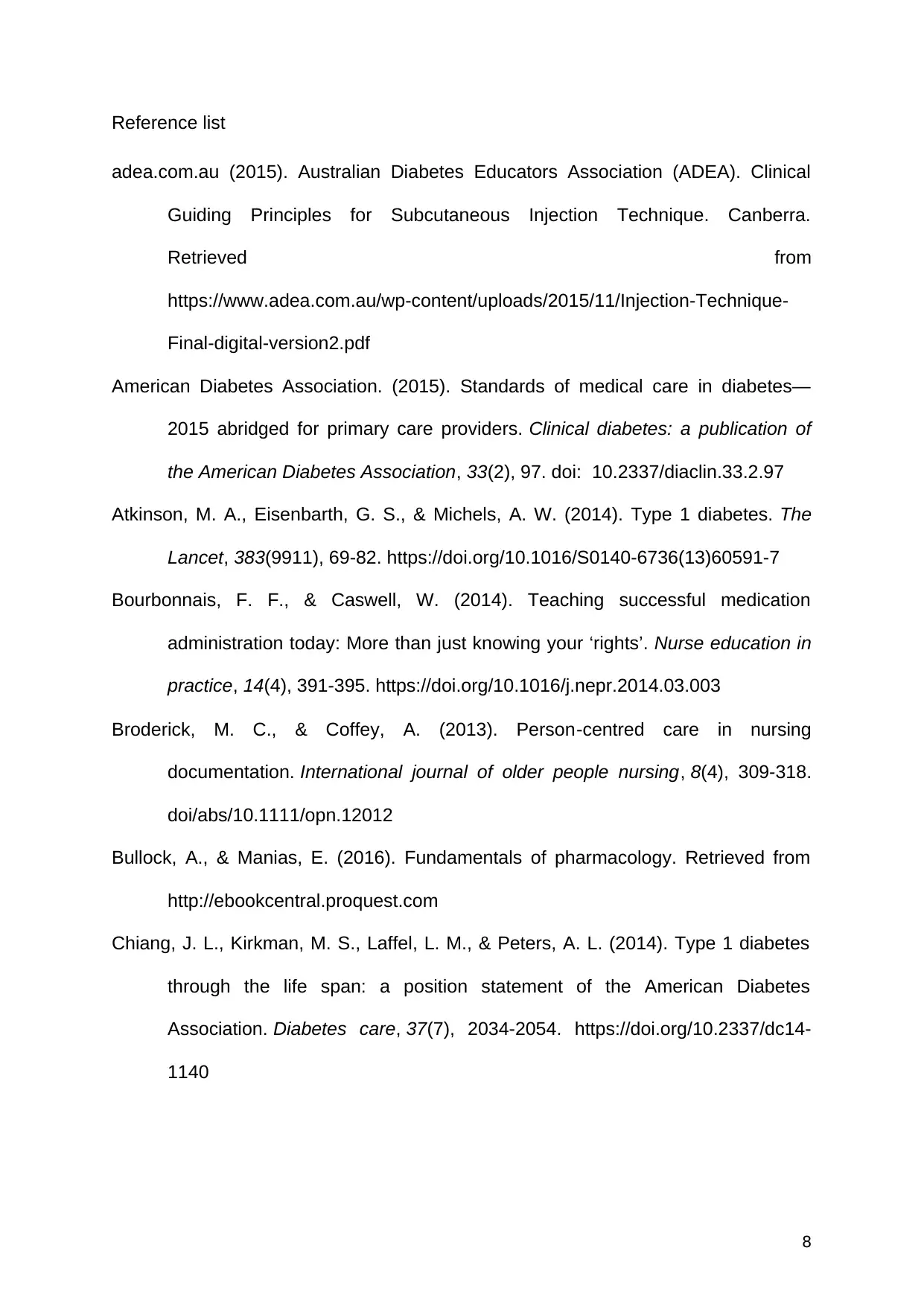
Reference list
adea.com.au (2015). Australian Diabetes Educators Association (ADEA). Clinical
Guiding Principles for Subcutaneous Injection Technique. Canberra.
Retrieved from
https://www.adea.com.au/wp-content/uploads/2015/11/Injection-Technique-
Final-digital-version2.pdf
American Diabetes Association. (2015). Standards of medical care in diabetes—
2015 abridged for primary care providers. Clinical diabetes: a publication of
the American Diabetes Association, 33(2), 97. doi: 10.2337/diaclin.33.2.97
Atkinson, M. A., Eisenbarth, G. S., & Michels, A. W. (2014). Type 1 diabetes. The
Lancet, 383(9911), 69-82. https://doi.org/10.1016/S0140-6736(13)60591-7
Bourbonnais, F. F., & Caswell, W. (2014). Teaching successful medication
administration today: More than just knowing your ‘rights’. Nurse education in
practice, 14(4), 391-395. https://doi.org/10.1016/j.nepr.2014.03.003
Broderick, M. C., & Coffey, A. (2013). Person‐centred care in nursing
documentation. International journal of older people nursing, 8(4), 309-318.
doi/abs/10.1111/opn.12012
Bullock, A., & Manias, E. (2016). Fundamentals of pharmacology. Retrieved from
http://ebookcentral.proquest.com
Chiang, J. L., Kirkman, M. S., Laffel, L. M., & Peters, A. L. (2014). Type 1 diabetes
through the life span: a position statement of the American Diabetes
Association. Diabetes care, 37(7), 2034-2054. https://doi.org/10.2337/dc14-
1140
8
adea.com.au (2015). Australian Diabetes Educators Association (ADEA). Clinical
Guiding Principles for Subcutaneous Injection Technique. Canberra.
Retrieved from
https://www.adea.com.au/wp-content/uploads/2015/11/Injection-Technique-
Final-digital-version2.pdf
American Diabetes Association. (2015). Standards of medical care in diabetes—
2015 abridged for primary care providers. Clinical diabetes: a publication of
the American Diabetes Association, 33(2), 97. doi: 10.2337/diaclin.33.2.97
Atkinson, M. A., Eisenbarth, G. S., & Michels, A. W. (2014). Type 1 diabetes. The
Lancet, 383(9911), 69-82. https://doi.org/10.1016/S0140-6736(13)60591-7
Bourbonnais, F. F., & Caswell, W. (2014). Teaching successful medication
administration today: More than just knowing your ‘rights’. Nurse education in
practice, 14(4), 391-395. https://doi.org/10.1016/j.nepr.2014.03.003
Broderick, M. C., & Coffey, A. (2013). Person‐centred care in nursing
documentation. International journal of older people nursing, 8(4), 309-318.
doi/abs/10.1111/opn.12012
Bullock, A., & Manias, E. (2016). Fundamentals of pharmacology. Retrieved from
http://ebookcentral.proquest.com
Chiang, J. L., Kirkman, M. S., Laffel, L. M., & Peters, A. L. (2014). Type 1 diabetes
through the life span: a position statement of the American Diabetes
Association. Diabetes care, 37(7), 2034-2054. https://doi.org/10.2337/dc14-
1140
8
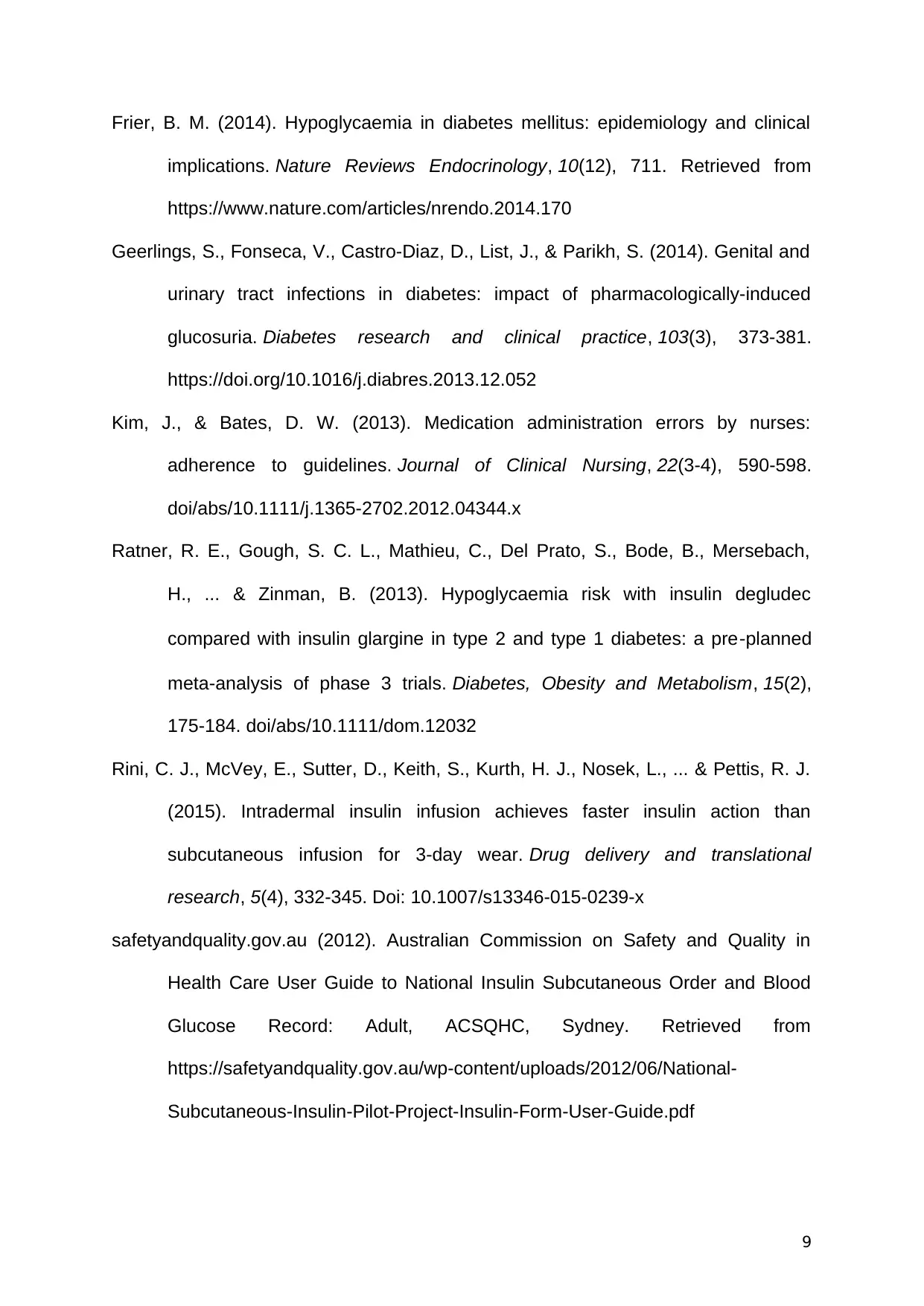
Frier, B. M. (2014). Hypoglycaemia in diabetes mellitus: epidemiology and clinical
implications. Nature Reviews Endocrinology, 10(12), 711. Retrieved from
https://www.nature.com/articles/nrendo.2014.170
Geerlings, S., Fonseca, V., Castro-Diaz, D., List, J., & Parikh, S. (2014). Genital and
urinary tract infections in diabetes: impact of pharmacologically-induced
glucosuria. Diabetes research and clinical practice, 103(3), 373-381.
https://doi.org/10.1016/j.diabres.2013.12.052
Kim, J., & Bates, D. W. (2013). Medication administration errors by nurses:
adherence to guidelines. Journal of Clinical Nursing, 22(3-4), 590-598.
doi/abs/10.1111/j.1365-2702.2012.04344.x
Ratner, R. E., Gough, S. C. L., Mathieu, C., Del Prato, S., Bode, B., Mersebach,
H., ... & Zinman, B. (2013). Hypoglycaemia risk with insulin degludec
compared with insulin glargine in type 2 and type 1 diabetes: a pre‐planned
meta‐analysis of phase 3 trials. Diabetes, Obesity and Metabolism, 15(2),
175-184. doi/abs/10.1111/dom.12032
Rini, C. J., McVey, E., Sutter, D., Keith, S., Kurth, H. J., Nosek, L., ... & Pettis, R. J.
(2015). Intradermal insulin infusion achieves faster insulin action than
subcutaneous infusion for 3-day wear. Drug delivery and translational
research, 5(4), 332-345. Doi: 10.1007/s13346-015-0239-x
safetyandquality.gov.au (2012). Australian Commission on Safety and Quality in
Health Care User Guide to National Insulin Subcutaneous Order and Blood
Glucose Record: Adult, ACSQHC, Sydney. Retrieved from
https://safetyandquality.gov.au/wp-content/uploads/2012/06/National-
Subcutaneous-Insulin-Pilot-Project-Insulin-Form-User-Guide.pdf
9
implications. Nature Reviews Endocrinology, 10(12), 711. Retrieved from
https://www.nature.com/articles/nrendo.2014.170
Geerlings, S., Fonseca, V., Castro-Diaz, D., List, J., & Parikh, S. (2014). Genital and
urinary tract infections in diabetes: impact of pharmacologically-induced
glucosuria. Diabetes research and clinical practice, 103(3), 373-381.
https://doi.org/10.1016/j.diabres.2013.12.052
Kim, J., & Bates, D. W. (2013). Medication administration errors by nurses:
adherence to guidelines. Journal of Clinical Nursing, 22(3-4), 590-598.
doi/abs/10.1111/j.1365-2702.2012.04344.x
Ratner, R. E., Gough, S. C. L., Mathieu, C., Del Prato, S., Bode, B., Mersebach,
H., ... & Zinman, B. (2013). Hypoglycaemia risk with insulin degludec
compared with insulin glargine in type 2 and type 1 diabetes: a pre‐planned
meta‐analysis of phase 3 trials. Diabetes, Obesity and Metabolism, 15(2),
175-184. doi/abs/10.1111/dom.12032
Rini, C. J., McVey, E., Sutter, D., Keith, S., Kurth, H. J., Nosek, L., ... & Pettis, R. J.
(2015). Intradermal insulin infusion achieves faster insulin action than
subcutaneous infusion for 3-day wear. Drug delivery and translational
research, 5(4), 332-345. Doi: 10.1007/s13346-015-0239-x
safetyandquality.gov.au (2012). Australian Commission on Safety and Quality in
Health Care User Guide to National Insulin Subcutaneous Order and Blood
Glucose Record: Adult, ACSQHC, Sydney. Retrieved from
https://safetyandquality.gov.au/wp-content/uploads/2012/06/National-
Subcutaneous-Insulin-Pilot-Project-Insulin-Form-User-Guide.pdf
9

10
1 out of 10
Related Documents
Your All-in-One AI-Powered Toolkit for Academic Success.
+13062052269
info@desklib.com
Available 24*7 on WhatsApp / Email
![[object Object]](/_next/static/media/star-bottom.7253800d.svg)
Unlock your academic potential
© 2024 | Zucol Services PVT LTD | All rights reserved.




